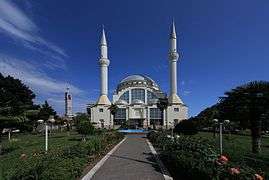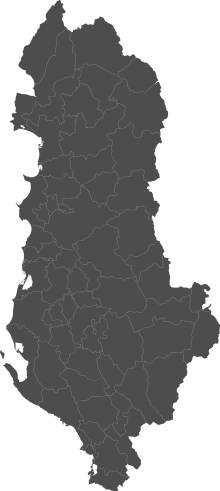Shkodër
| Shkodër | |||
|---|---|---|---|
| Municipality | |||
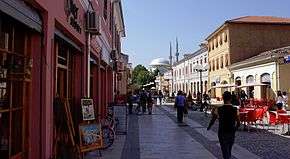 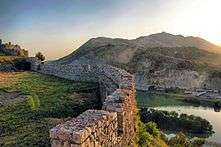     Shkodra photomontage | |||
| |||
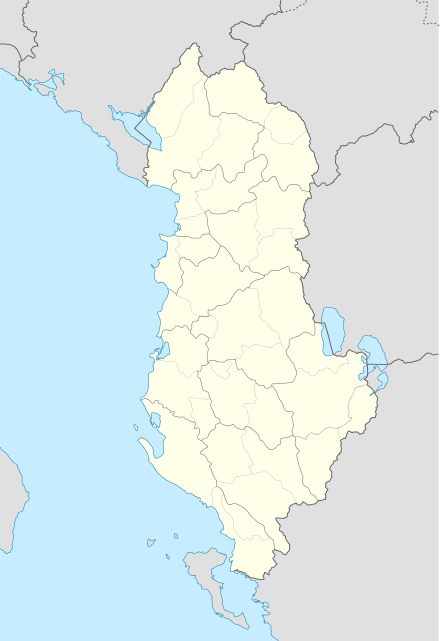 Shkodër | |||
| Coordinates: 42°04′N 19°30′E / 42.067°N 19.500°E | |||
| Country |
| ||
| County |
| ||
| Government | |||
| • Mayor | Voltana Ademi (PD) | ||
| Area | |||
| • Municipality | 872.71 km2 (336.96 sq mi) | ||
| Elevation | 13 m (43 ft) | ||
| Population (2011) | |||
| • Municipality | 135,612 | ||
| • Municipality density | 160/km2 (400/sq mi) | ||
| Demonym(s) | Shkodran/e | ||
| Time zone | UTC+1 (CET) | ||
| • Summer (DST) | UTC+2 (CEST) | ||
| Postal Code | 4001-4007 | ||
| Area Code | (0)22 | ||
| Vehicle registration | AL | ||
| Website | Official Website | ||
Shkodër, Shkodra or Skadar (Albanian pronunciation: [ˈʃkɔdəɾ]), historically known as Scutari (in Italian, English and most Western European languages) or Scodra, is a city in the Republic of Albania. It is the capital of the surrounding county of Shkodër, one of 12 constituent counties of the republic. The city is one of the most ancient cities in the Balkans and the fourth most populous city in the country and exerts strong influences in culture, religion, arts and entertainment of northern Albania.
Geographically, the city of Shkodër sprawls across the Mbishkodra plain between the freshwater marshlands of Lake Shkodër and the foothills of the Albanian Alps.[1] Like most of the Dinaric Alps, the mountains are dominated by limestone and dolomite rocks. The lake, named after the city of Shkodër, is the largest lake in Southern Europe close to the Adriatic Sea. The city is trapped on three sides by the rivers Kir in the east, Drin in the south and Buna in the west.
The region that today corresponds to the city territory was founded in the 4th century BC by the ancient Illyrian tribes of the Ardiaei and Labeates.[2] It is evidenced by the artefacts and inscriptions that were discovered in the Rozafa Castle. During that time the city was known under the name Scodra. The city has historically developed on a 130 metres (430 ft) hill, strategically located in the outflow of Lake Shkodër into the Buna. The Romans annexed the city after the third Illyrian War in 168 BC, when Gentius was defeated by the Roman force of Anicius Gallus.[2][3] In the 3rd century AD, Shkodër became the capital of Praevalitana due to the administrative reform of the Roman emperor Diocletian. With the spread of Christianity in the 4th century, the Archdiocese of Scodra was founded and was assumed in 535 by Byzantine Justinian I.
During many different epochs it has retained its status as a major city in the wider region, due to its strategic position close to the Adriatic Sea and the Italian port cities, but also with land-routes to other important cities and towns in neighbouring regions.
Etymology
The etymology of the term Shkodër is a subject which attracts debate. The name was first attested in antiquity in the Latin form Scodra, the Ancient Greek Σκόδρα and the Ancient Greek genitive Σκοδρινῶν (of the Skodrians), which was discovered on coins from the 2nd century BC.[4][5][6] Although the ultimate origin of the term is uncertain.[7]
The further development of the name has been a subject of discussion among linguists over the linguistic provenance of the Albanian people and the Albanian language. While Eqrem Çabej and Shaban Demiraj treat the development from Skodra to modern Shkodra as evidence of regular development within the Albanian language, Matzinger argues that it fails to display certain known phonological changes that would have to have happened if the name had been continually in use in proto-Albanian since pre-Roman times.[8][9][7]
In modern times, the term was adapted to Italian as Scutari; in this form it was also in wide use in English until the 20th century.[10] In Serbo-Croatian, Shkodër is known as Skadar (Скадар), and in Turkish as İşkodra.
Geography
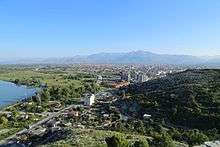
Shkodër is the largest city in northern Albania, lying near latitude 42° 4' N, and longitude 19 ° 31' E. Geologically, Shkodër extends strategically on the Mbishkodra Plain between the marshlands of Lake Shkodër and the foothills of the Albanian Alps, the southernmost continuation of the Dinaric Alps. The northeast is dominated by Mount Maranaj standing at 1,576 metres (5,171 ft) above the Adriatic. Hydrologically, the city is trapped on three sides by the rivers Kir in the east, Drin in the south and Buna in the west. Rising From Lake Shkodër, Buna flows into the Adriatic Sea, forming the border with Montenegro. The river joins the Drin for approximately 2 kilometres (1.2 mi) southwest of the city. In the east, Shkodër is bordered by Kir, which originates from the north flowing also into the Drin, that surrounds Shkodër in the south. The location of Shkodër has been of great strategic importance in its history. It has often helped the city to its wealth in its history or made it the subject of conflicts between foreign powers.
Lake Shkodër lies in the west of the city and forms the frontier of Albania and Montenegro. The lake became the symbol of the stable and consistent economic and social divide of the city. Although, the lake is the largest lake in Southern Europe and an important habitat for various animal and plant species. Further, the Albanian section has been designated as a Nature Reserve. In 1996, it also has been recognised as a wetland of international importance by designation under the Ramsar Convention.[11] River Buna connects the lake with the Adriatic Sea, while the Drin provides a link with Lake Ohrid in the southeast of Albania.[12] It is a cryptodepression, filled by the river Morača and drained into the Adriatic by the 41 km (25 mi) long Buna.
Climate
According to the Köppen climate classification, Shkodër experiences mediterranean climate, that is almost wet enough in July to be a humid subtropical climate, with continental influences.[13] The average yearly temperature varies from 14.5 °C (58.1 °F) to 16.8 °C (62.2 °F). Although, mean monthly temperature ranges between 1.4 °C (34.5 °F) to 9.8 °C (49.6 °F) in January and 19.3 °C (66.7 °F) to 32.4 °C (90.3 °F) in August. The average yearly precipitation is about 1,700 millimetres (66.9 in), which makes the area one of the wettest in Europe.
| Climate data for Shkodra (1981-2010) | |||||||||||||
|---|---|---|---|---|---|---|---|---|---|---|---|---|---|
| Month | Jan | Feb | Mar | Apr | May | Jun | Jul | Aug | Sep | Oct | Nov | Dec | Year |
| Average high °C (°F) | 9.8 (49.6) |
11.0 (51.8) |
14.8 (58.6) |
18.5 (65.3) |
24.2 (75.6) |
28.1 (82.6) |
32.1 (89.8) |
32.4 (90.3) |
27.5 (81.5) |
21.7 (71.1) |
14.9 (58.8) |
10.5 (50.9) |
20.5 (68.9) |
| Daily mean °C (°F) | 5.6 (42.1) |
6.6 (43.9) |
10.1 (50.2) |
13.8 (56.8) |
18.7 (65.7) |
22.3 (72.1) |
25.4 (77.7) |
25.8 (78.4) |
21.5 (70.7) |
16.5 (61.7) |
10.6 (51.1) |
7.0 (44.6) |
15.3 (59.5) |
| Average low °C (°F) | 1.4 (34.5) |
2.1 (35.8) |
5.2 (41.4) |
9.0 (48.2) |
13.2 (55.8) |
16.5 (61.7) |
18.7 (65.7) |
19.3 (66.7) |
15.5 (59.9) |
11.2 (52.2) |
6.4 (43.5) |
3.4 (38.1) |
10.1 (50.2) |
| Average rainfall mm (inches) | 161.8 (6.37) |
159.0 (6.26) |
142.1 (5.594) |
147.6 (5.811) |
86.4 (3.402) |
50.6 (1.992) |
34.1 (1.343) |
58.2 (2.291) |
190.9 (7.516) |
206.6 (8.134) |
229.8 (9.047) |
211.1 (8.311) |
1,678.2 (66.071) |
| Average rainy days (≥ 1.0 mm) | 9 | 9 | 9 | 9 | 7 | 5 | 2 | 4 | 6 | 9 | 11 | 12 | 92 |
| Source: meteo-climat-bzh[14] | |||||||||||||
History
Early history

The earliest signs of human activity in the lands of Shkodër can be traced back to the Bronze Age.[15] The favorable conditions on the fertile plain, around the lake, have brought people here from early antiquity. Artefacts and inscriptions, discovered in the Rozafa Castle, are assumed to be the earliest examples of symbolic behaviour in humans in the city. Although, it was known under the name Scodra and was inhabited by the Illyrian tribe of the Ardiaei, which ruled over a large territory between modern Albania up to Croatia.[16][17][18] Queen Teuta, King Agron, and King Gentius, were among the most famous personalities of the Labeates.
The city was first mentioned during the antiquity as the site of the Illyrian Labeates in which he minted coins and that of Queen Teuta.[19] In 168 BC, the city was captured by the Romans and became an important trade and military route. The Romans colonized[20] the town. Scodra remained in the province of Illyricum, and later Dalmatia. By it 395 AD, it was part of the Diocese of Dacia, within Praevalitana.
The dawn of the Middle Ages saw the migration of Slavs. De Administrando Imperio describes how Byzantine Emperor Heraclius gave the Serbs a territory in this region during the first half of the 7th century. The southernmost, maritime polity of the Serbian Principality at Duklja, included the Shkodër region. After the death of Prince Caslav, the state disintegrated with Duklja retaining most of it.[21] Tsar Samuel of Bulgaria had by 997 conquered all of Thessaly, Epirus, Macedonia and most of Albania.[21] In the early 11th century, Jovan Vladimir ruled Duklja amidst the war between Basil II and Samuel. Vladimir allegedly retreated into Koplik when Samuel invaded Duklja and was subsequently forced to accept Bulgarian vassalage. Vladimir was later slain by the Bulgarians. Shingjon (feast of Jovan Vladimir) has since been celebrated by Albanian Orthodox Christians.[22]
_-_Foto_Giovanni_Dall'Orto%2C_12-Aug-2007_-_11_-_Maometto_II_assedia_Scutari.jpg)
In the 1030s, Stefan Vojislav from Travunia expelled the last strategos and successfully defeated the Byzantines by 1042. Stefan Vojislav set up Shkodër as his capital.[23] Constantine Bodin accepted the crusaders of the Crusade of 1101 in Shkodër. After the dynastic struggles in the 12th century, Shkodër became part of the Nemanjić Zeta province. In 1214 the city became part of the Despotate of Epirus under Michael I Komnenos Doukas.[24] In 1330, Stephen Decanski appointed his son Stefan Dusan as the governor of Zeta and its seat Shkodër.[25] In the same year Dusan and his father entered the conflict which resulted with campaign of Decanski who destroyed Dusans court on Drin River near Shkodër in January 1331. In April 1331, they made a truce,[26] but in August 1331 Dušan went from Shkodër to Nerodimlje and overthrew his father.[27]
In the 14th century, Shkodër was taken by the Balsic family, who surrendered the city to the Republic of Venice in 1396, in order to form a protection zone from the Ottoman Empire. During the Venetian rule the city adopted the Statutes of Scutari, a civic law written in Venetian. Venetians built the St. Stephen's Church (later converted into the Fatih Sultan Mehmet Mosque by the Turks) and the Rozafa Castle. In 1478-79 Mehmed the conqueror laid siege on Shkodër. In 1479 the city fell to the Ottomans and the defenders of the citadel emigrated to Venice, while many Albanians from the region retreated into the mountains. The city then became a seat of a newly established Ottoman sanjak, the Sanjak of Scutari.
Ottoman Period
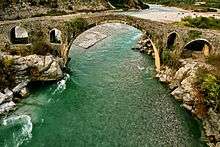
With two sieges, Shkodër became secure as an Ottoman territory. It became the centre of the sanjak and by 1485 there were 27 Muslim and 70 Christian hearths, although by the end of the next century there were more than 200 Muslim ones compared to the 27 Christian ones, respectively.[28]
Military manoeuvres in 1478 by the Ottomans meant that the city was again entirely surrounded by Ottoman forces. Mehmed the Conqueror personally laid the siege. About ten heavy cannons were cast on site. Balls as heavy as 380 kg (838 lb) were fired on the citadel (such balls are still on display on the castle museum). Nevertheless, the city resisted. Mehmed left the field and had his commanders continue the siege. By the winter the Ottomans had captured one after the other all adjacent castles: Lezhë, Drisht, and Žabljak Crnojevića. This, together with famine and constant bombardment lowered the morale of defenders. On the other hand, the Ottomans were already frustrated by the stubborn resistance. The castle is situated on a naturally protected hill and every attempted assault resulted in considerable casualties for the attackers. A truce became an option for both parties. On January 25 an agreement between the Venetians and the Ottoman Empire ended the siege, permitting the citizens to leave unharmed, and the Ottomans to take over the deserted city.
After Ottoman domination was secure, much of the population fled. Around the 17th century, the city began to prosper as the center of the Sanjak of Scutari (sanjak was an Ottoman administrative unit smaller than a vilayet). It became the economic center of northern Albania, its craftsmen producing fabric, silk, arms, and silver artifacts. Construction included two-story stone houses, the bazaar, and the Central or Middle Bridge (Ura e Mesit) over the Kir river, built during the second half of the 18th century, over 100 metres (330 feet) long, with 13 arcs of stone, the largest one being 22 metres (72 feet) wide and 12 metres (39 feet) tall.
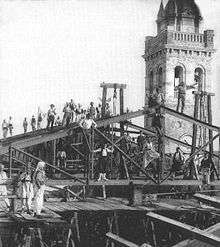
Shkodër was a major city under Ottoman rule in Southeast Europe. It retained its importance up until the end of the empire's rule in the Balkans in the early 20th century. This is due to its geo-strategic position that connects it directly with the Adriatic and with the Italian ports, but also with land-routes to the other important Ottoman centre, namely Prizren. The city was an important meeting place of diverse cultures from other parts of the Empire, as well as influences coming westwards, by Italian merchants. It was a centre of Islam in the region, producing many ulema, poets and administrators, particularly from the Bushati family.
In the 18th century Shkodër became the center of the (pashaluk) of Shkodër, under the rule of the Bushati family, which ruled from 1757 to 1831. Shkodër's importance as a trade center in the second half of the 19th century was owed to the fact that it was the center of the vilayet of Shkodër, and an important trading center for the entire Balkan peninsula. It had over 3,500 shops, and clothing, leather, tobacco, and gunpowder were some of the major products of Shkodër. A special administration was established to handle trade, a trade court, and a directorate of postage services with other countries. Other countries had opened consulates in Shkodër ever since 1718. Obot and Ulcinj served as ports for Shkodër, and later on Shëngjin (San Giovanni di Medua). The Jesuit seminary and the Franciscan committee were opened in the 19th century.
Before 1867 Shkodër (İşkodra) was a sanjak of Rumelia Eyalet in Ottoman Empire. In 1867, Shkodër sanjak merged with Skopje (Üsküp) sanjak and became Shkodër vilayet. Shkodër vilayet was split into Shkodër, Prizren and Dibra sanjaks. In 1877, Prizren passed to Kosovo vilayet and Debar passed to Monastir vilayet, while Durrës township became a sanjak. In 1878 Bar and Podgorica townships belonged to Montenegro. Ottoman-Albanian intellectual Sami Frashëri during the 1880s estimated the population of Shkodër as numbering 37,000 inhabitants that consisted of three quarters being Muslims and the rest Christians made up of mostly Catholics and a few hundred Orthodox.[29] In 1900, Shkodër vilayet was split into Shkodër and Durrës sanjaks.
Modern

Shkodër played an important role during the League of Prizren, the Albanian liberation movement. The people of Shkodër participated in battles to protect Albanian land. The branch of the League of Prizren for Shkodër, which had its own armed unit, fought for the protection of Plav, Gusinje, Hoti, and Gruda, and the war for the protection of Ulcinj. The Bushati Library, built during the 1840s, served as a center for the League of Prizren's branch for Shkodër. Many books were collected in libraries of Catholic missionaries working in Shkodër. Literary, cultural, and sports associations were formed, such as Bashkimi ("The Union") and Agimi ("The Dawn"). The first Albanian newspapers and publications printed in Albania came out of the printing press of Shkodër. The Marubi family of photographers began working in Shkodër, which left behind over 150,000 negatives from the period of the Albanian liberation movement, the rise of the Albanian flag in Vlorë, and life in Albanian towns during the end of the 19th and the beginning of the 20th century.
During the Balkan Wars, Shkodër went from one occupation to another, when the Ottomans were defeated by the Kingdom of Montenegro. The Ottoman forces led by Hasan Riza Pasha and Esad Pasha had resisted for seven months the surrounding of the town by Montenegrin forces and their Serbian allies. Esad (Hasan had previously been mysteriously killed by Esad Pasha Toptani in an ambush inside the town) finally surrendered to Montenegro in April 1913, after Montenegro suffered a high death toll with more than 10,000 casualties. Miss Edith Durham also notes the cruelties suffered at the hand of Montenegrins in the wake of October 1913: "Thousands of refugees arriving from Djakovo and neighbourhood. Victims of Montenegro. My position was indescribably painful, for I had no funds left, and women came to me crying: 'If you will not feed my child, throw it in the river. I cannot see it starve.'"[30] Montenegro was compelled to leave the city to the new country of Albania in May 1913, in accordance with the London Conference of Ambassadors.
During World War I, Montenegrin forces again occupied Shkodër on June 27, 1915. In January 1916, Shkodër was taken over by Austria-Hungary and was the center of the zone of their occupation. When the war ended on 11 November 1918, French forces occupied Shkodër as well as other regions with sizable Albanian populations. After World War I, the international military administration of Albania was temporarily located in Shkodër, and in March 1920, Shkodër was put under the administration of the national government of Tirana. In the second half of 1920, Shkodër resisted another threat, the military intervention of the forces of the Kingdom of Serbs, Croats and Slovenes.
Shkodër was the center of democratic movements of the years 1921–1924. The democratic opposition won the majority of votes for the Constitutional Assembly, and on May 31, 1924, the democratic forces took over the town and from Shkodër headed to Tirana. From 1924 to 1939, Shkodër had a slow industrial development, small factories that produced food, textile, and cement were opened. From 43 of such in 1924, the number rose to 70 in 1938. In 1924, Shkodër had 20,000 inhabitants, the number grew to 29,000 in 1938.
Shkodër was the seat of a Catholic archbishopric and had a number of religious schools. The first laic school was opened here in 1913, and the State Gymnasium was opened in 1922. It was the center of many cultural associations. In sports Shkodër was the first city in Albania to constitute a sports association, the "Vllaznia" (brotherhood). Vllaznia Shkodër is the oldest sport club in Albania.
During the early 1990s, Shkodër was once again a major center, this time of the democratic movement that finally brought to an end the communist regime established by Enver Hoxha. In the later 2000s (decade), the city experiences a rebirth as main streets are being paved, buildings painted and streets renamed. In December 2010, Shkodër and the surrounding region was hit by probably the worst flooding in the last 100 years.[31] In 2011, a new swing bridge over the Buna River was constructed, thus replacing the old bridge nearby.
Demographics
The 20th century found Shkodër with a population of around 30,000 – 40,000. After Albanian Independence in 1912 the city numbered 23,000 inhabitants. Surveys in 1926-27 showed the city not to have experienced any relative growth, a figure of 23,784 inhabitants being given, which was the same figure as confirmed for the data of the population census of 1918, according to which Shkodër in 1918 had a population of 23,099.
In 1918, the majority – two thirds – of the population was Muslim and one third was Catholic with a small community of Orthodox faith of Slavic and Vlah origin who immigrated to Shkodër during the 19th century.[32] The city was divided into 12 mahallas, of which nine were inhabited by the Muslim and three by the Catholic population, and a separated bazaar. The Muslims were mostly to be found in the quarters on the west side of the city while the Catholics were living in the quarters on the east side of the city.[32] The Orthodox population mostly lived within the Muslim quarters.
As of current, Shkodër is the 4th most populous city in Albania and the largest city in the Shkodër County. According to the Albanian national Institute of Statistics (INSTAT), the city of Shkodër include 77,075 people as of the 2011 Census.[33] About 197,357 (91.65%) of the population are Albanians, 694 (0.32%) Ashkali and Balkan Egyptians, 282 (0.13%) Montenegrins and 13,665 (6.35%) did not declare their ethnicity.[34] The city of Shkodër was one of the most important centres for Islamic scholars and cultural and literary activity in Albania. Here stands the site of the only institution in Albania which provides high-level education in Arabic, Turkish and Islamic Studies.[35] Shkodër is the center of Roman Catholicism in Albania. The Roman Catholic Church is represented in Shkodër by the episcopal seat of the Metropolitan Roman Catholic Archdiocese of Shkodër-Pult (Scutari-Pulati) in Shkodër Cathedral, with the current seat of the prelacy. According to Institute of Statistics (INSTAT), Catholics make up about 47% of the population followed by Muslims (including the Bektashi minority) with 45%. About 1.5% of the population identify as non-Catholic Christians, 0.14% are Atheists and 0.31% identify themselves as believers without denomination.[36]
Politics
The present municipality, which now extends from the Albanian Alps to the Adriatic Sea, was formed at the 2015 local government reform by the merger of the former municipalities Ana e Malit, Bërdicë, Dajç, Guri i Zi, Postribë, Pult, Rrethinat, Shalë, Shkodër, Shosh and Velipojë, that became municipal units. The seat of the municipality is the city Shkodër.[37] The total population is 135,612 (2011 census), in a total area of 872.71 km2.[38] The population of the former municipality at the 2011 census was 77,075.[39]
Economy
The main activities of the processing industry in Shkodra were the processing of tobacco and manufacture of cigarettes, production of preserved foods, sugar - based foods, soft and alcoholic drinks, and pasta, bread, rice and vegetable oil. The main activities of the textile industry were focused on garments and silk products. The city also had a wood-processing and paper-production plant. The most important mechanical engineering industries concerned wire manufacturing, elevator manufacturing, bus assembly and the Drini Plant.[40]
According to the World Bank, Shkodër has had significant steps of improving the economy in recent years. In 2016, Shkodër ranked 8[41] among 22 cities in Southeastern Europe before the capital Tirana, Belgrade, Serbia and Sarajevo, Bosnia and Herzegovina.
Infrastructure
As the largest city in northern Albania, the city is the main road connection between the Albanian capital, Tirana and Montenegrin capital Podgorica. The SH1 leads to the Albanian - Montenegrin border at Han i Hotit border crossing. From Tirana at the Kamza Bypass northward, it passes through Fushë-Kruja, Milot, Lezha, Shkodra, and Koplik. The road segment between Hani i Hotit at the Montenegrin border and Shkodra was completed in 2013 as a single carriageway standard. Shkodër Bypass started after the 2010 Albania floods. It was planned to incorporate a defensive dam against Shkodër Lake but works were abandoned a few years later. The road continues as a single carriageway down to Milot and contains some uncontrolled and dangerous entry and exit points. The SH5 starts from Shkodër to Morinë.
Culture
Shkodër is an important educational and industrial center. The city produces various mechanical and electrical components, along with textile and food products. Luigj Gurakuqi University of Shkodër is one of the more prestigious learning centers of Albania. The public library of the city contains more than 250,000 books. Other cultural institutions include the Cultural Center, the Marubi Photo Archives, the Artists and Writers Association, the Migjeni Theatre (named after Millosh Gjergj Nikolla), the Gallery of Arts and the Museum of History. Historic cultural architecture includes the Castle of Shkodër, the Turkish Bath, and the Lead Mosque. The Castle of Shkodër became famous during the First Balkan War when it was protected by the Turkish general Hasan Riza Pasha and Esad Pasha. Many festivals take place on an annual basis such as Carnival, Children Festival, Lake Day and Shkodra Jazz Fest.
Music
City tunes differ from the rural music of the land, but both enjoy popularity in Shkodra. Northern music is a refined combination of romantic and sophisticated undertones with oriental-sounding scales and a constant interplay of major and minor. It bears a significant affinity with the sevdalinke of Bosnia, but differs from them in their extreme forms while maintaining a typically Albanian quality through the exceptional fluidity of rhythm and tempo. Early descriptions of such music groups, which date from the end of the 19th century, suggest use of the violin, clarinet, saze, defi, and sometimes Indian-style harmonium and percussion (provided by rattling a stick between two bottles). Today, the accordion and guitar have replaced the more exotic instruments. Among the most important players are Bik Ndoja, Luçije Miloti, Xhevdet Hafizi and Bujar Qamili.
Sights
The city and the surrounding area are blessed with a large variety of natural and cultural elements. The most attractive quarters of the city are commonly thought to be Pjaca, identifiable as the main city centre between statues of Mother Teresa and Luigj Gurakuqi, and Gjuhadol, the neighborhood around one of the most scenic streets connecting the Cathedral on the east side of town with the middle of the city. The most recognizable memorial is the legendary Castle of Rozafa known also as Rozafati. Lake of Shkodër is the largest lake in South Europe. It is a major summer attraction for tourists and inhabitants. Another interesting historical site is the ruins of Shurdhah (Sarda), a medieval town situated only 15 kilometres (9 miles) from Shkodër. To go out there you must take a motor-boat from the dam of Vau i Dejës out to the island where Shurdhah is located (about 10 miles, or 16 km). Shurdhah was built atop a hill on the island, roughly 5 ha in area, surrounded by the waters of the Drini river (which has been rerouted now to form an artificial lake). At one time it was the summer retreat of the famous Dukagjini Family. About 5 km (3 mi) east of Shkodër lies the medieval citadel of Drisht.
Many visitors feel that Shkodër is the soul of Albania. The very characteristic appearance of the city is formed by the juxtaposition of ancient houses and narrow streets joined with stone walls and modern buildings. After World War II, some of Shkodër was rebuilt with wider streets to accommodate automotive traffic, and new residential buildings are being constructed all the time.
Monuments include, the Rozafa Castle, the Mes Bridge, the Lead Mosque, the Ebu Beker Mosque, the Shkodër Cathedral, the Shkodër Orthodox Cathedral, the Kratul and the Shirgj Church.
Notable people
Below are some of the most notable personalities born or long time residents in Shkodër:
|
|
|
|
International relations
Shkodër is twinned with:
See also
| Wikimedia Commons has media related to Shkodër. |
| Wikivoyage has a travel guide for Shkodra. |
Notes
- ↑ Kosovo is the subject of a territorial dispute between the Republic of Kosovo and the Republic of Serbia. The Republic of Kosovo unilaterally declared independence on 17 February 2008, but Serbia continues to claim it as part of its own sovereign territory. The two governments began to normalise relations in 2013, as part of the Brussels Agreement. Kosovo has received formal recognition as an independent state from 113 out of 193 United Nations member states.
Sources
- Fine, John Van Antwerp (1991). The Early Medieval Balkans: A Critical Survey from the Sixth to the Late Twelfth Century. Michigan: The University of Michigan Press. ISBN 0-472-08149-7.
- Koti, Isidor (2006). "Celebration of Saint John Vladimir in Elbasan". Orthodox Autocephalous Church of Albania. Archived from the original on 2011-07-16.
- Wilkes, John J. (1995). The Illyrians. Oxford, United Kingdom: Blackwell Publishing. ISBN 0-631-19807-5.
References
- ↑ University of Tirana. "HAPËSIRA PERIURBANE E SHKODRËS: PËRDORIMI I TERRITORIT DHE VEÇORITË E ZHVILLIMIT SOCIAL-EKONOMIK" (PDF). doktoratura.unitir.edu.al (in Albanian). p. 34.
- 1 2 University of Shkodra. "THE SOCIAL AND CULTURAL IMPACTS OF TOURISM, A CASE OF SHKODRA, ALBANIA" (PDF). dukagjinicollege.eu. p. 1.
- ↑ Battles of the Greek and Roman Worlds: A Chronological Compendium of 667 Battles to 31Bc, from the Historians of the Ancient World (Greenhill Historic Series) by John Drogo Montagu, ISBN 1-85367-389-7, 2000, page 47
- ↑ Krahe, Hans (1925). Die alten balkanillyrischen geographischen Namen auf Grund von Autoren und Inschriften. Heidelberg. p. 36.
- ↑ e.g. Ptolemy, Geographia II.16.; Polybius, Histories, XXVII.8.
- ↑ Wilkes, John (1992). The Illyrians. pp. 177–179. ISBN 0-631-19807-5.
- 1 2 Matzinger, Joachim (2009). "Die Albaner als Nachkommen der Illyrer aus der Sicht der historischen Sprachwissenschaft". In Schmitt, Oliver Jens; Frantz, Eva Anne. Albanische Geschichte: Stand und Perspektiven der Forschung. Munich: Oldenbourg. pp. 22–24.
- ↑ Cabej, Eqrem (1974). "Die Frage nach dem Entstehungsgebiet der albanischen Sprache". Zeitschrift für Balkanologie. 1012: 7–32. ; cited after Matzinger 2009.
- ↑ Demiraj, Shaban (1999). Prejardhja e shqiptarëve nën dritën e dëshmive të gjuhës shqipe. Tirana. pp. 143–144. ; cited after Matzinger 2009.
- ↑ Encyclopædia Britannica, 11th edition (1911), "Scutari" article.
- ↑ Ramsar (August 4, 2010). "The list of wetlands of international importance" (PDF) (in English and Spanish). Ramsar. p. 5. Retrieved 14 August 2010.
- ↑ Pešić V. & Glöer P. (2013). "A new freshwater snail genus (Hydrobiidae, Gastropoda) from Montenegro, with a discussion on gastropod diversity and endemism in Skadar Lake". ZooKeys 281: 69-90. doi:10.3897/zookeys.281.4409
- ↑ "BASHKIA E SHKODRËS" (PDF). flag-al.org (in Albanian). p. 28.
- ↑ "moyennes 1981/2010".
- ↑ "Historia dhe të dhëna gjeografike" (in Albanian).
- ↑ Polybius
- ↑ Titus Livius
- ↑ Encyclopædia Britannica 2002 page 680
- ↑ The Illyrians by John Wilkes, ISBN 0-631-19807-5, 1992, page 172, "...Gentius among the Labeates around Scodra/"
- ↑ The Illyrians by John Wilkes, page 213,"The list of Roman settlements includes some of the... Scodra..."
- 1 2 Fine 1991, p. 193
- ↑ Koti 2006, para. 1, 2
- ↑ Fine 1991, p. 206
- ↑ Fine, John V. A.; Fine, John Van Antwerp (1994). The Late Medieval Balkans: A Critical Survey from the Late Twelfth Century to the Ottoman Conquest. University of Michigan Press. p. 104. ISBN 0472082604.
- ↑ Miladin Stevanović; Vuk Branković (srpski velmoža.) (2004). Vuk Branković. Knjiga-komerc. p. 38. Retrieved 20 April 2013.
После битке код Велбужда млади краљ Душан, чији је углед знатно порастао, добио је од оца на управљање Зету са седиштем у Скадру.
- ↑ Jović, Momir (1994). Srbija i Rimokatolička crkva u srednjem veku. Bagdala. p. 102. Retrieved 21 December 2013.
Краљ је у јануару 1331. г. разорио Душанов двор на реци Дримац, код Скадра. Половином априла долази до примирја
- ↑ Nikolić, Dejan (1996). Svi vladari Srbije. Narodna biblioteka "Resavska škola". p. 102. Retrieved 21 December 2013.
Стефан Душан је августа 1331. крен- уо са својом војском из Скадра и дошао до Стефановог дворца у Неродимљу, где је изненадио оца. Краљ Стефан је једва успео да побегне из свог дворца у град Петрич у коме га је Душанова војска опколила
- ↑ Clayer, Nathalie. " Is̲h̲ḳodra." Encyclopaedia of Islam, Second Edition. Brill Online, 2012. Reference. 2 January 2012 <http://referenceworks.brillonline.com/entries/encyclopaedia-of-islam-2/ishkodra-SIM_8713>
- ↑ Gawrych, George (2006). The Crescent and the Eagle: Ottoman rule, Islam and the Albanians, 1874–1913. London: IB Tauris. pp. 29, 217. ISBN 9781845112875.
- ↑ Twenty Years of Balkan Tangle: M.Edith Durham
- ↑ "Nato joins Albania rescue effort after Balkan floods". BBC News. 6 December 2010.
- 1 2 Hemming, Andreas (2012). Albania: Family, Society and Culture in the 20th Century. Zurich: Lit Verlag. p. 51. Retrieved 2018-07-15.
- ↑ "2011 Albanian national census Archived copy" (PDF). Archived from the original (PDF) on 12 January 2012. Retrieved 2012-06-21.
- ↑ Template:2011 Albanian national census.
- ↑ Norris, H. T (1993). Islam in the Balkans: Religion and Society Between Europe and the Arab World. Columbia, South Carolina: University of South Carolina Press. p. 76. ISBN 0 87249 977 4. Retrieved 2016-05-12.
- ↑ "Population and Housing Census Shkoder 2011" (PDF). Archived from the original (PDF) on 2016-03-03.
- ↑ Law nr. 115/2014
- ↑ "Interactive map administrative territorial reform". Archived from the original on 2017-01-12. Retrieved 2017-08-27.
- ↑ 2011 census results Archived 2016-03-03 at the Wayback Machine.
- ↑ http://siteresources.worldbank.org/INTLED/Resources/339650-1122490529659/Shkodra.pdf
- ↑ http://www.doingbusiness.org/Rankings/south-east-europe


